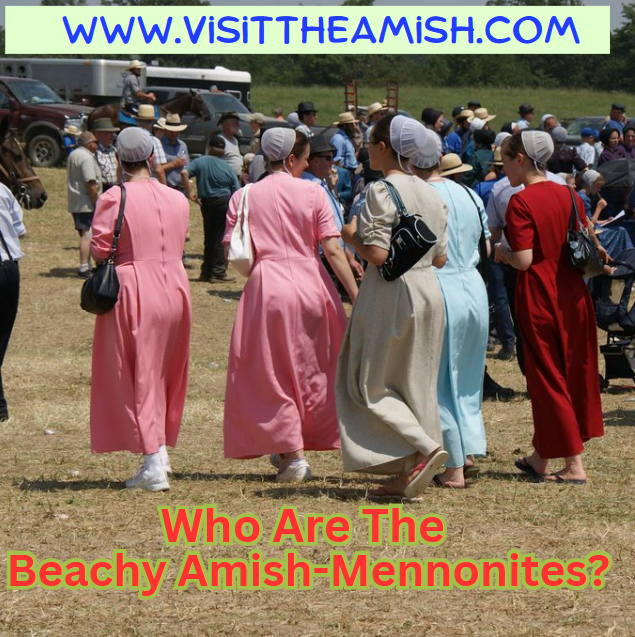The Beachy Amish-Mennonites are a conservative Mennonite group that originated in the 1920s in the United States. They are often referred to as “Beachy Amish” because of their more relaxed dress codes compared to traditional Amish communities, which allow for the use of brighter colors and more fashionable styles.
The Beachy Amish-Mennonites represent a distinct branch within the Amish-Mennonite community, characterized by their embrace of certain modern conveniences while maintaining their traditional values. Unlike their horse-and-buggy counterparts, the Beachy Amish-Mennonites incorporate car transportation into their daily lives and prioritize community outreach efforts. Just as there are diverse subgroups among the horse-and-buggy Amish, the Amish-Mennonites also exhibit variations in their beliefs and practices.
Although the Beachy faction is the largest among the Amish-Mennonites today, comprising over 50% of the community, there are seven other groups that contribute to the overall diversity. The Beachy Amish-Mennonites utilize automobiles, cameras, and computers while abstaining from radio and television. They adhere to prescribed dress codes and maintain a somewhat evangelical approach to their faith.
Like other Mennonite groups, the Beachy Amish-Mennonites believe in non-violent conflict resolution, adult baptism, and separation of church and state. However, they are more accepting of modern technology and do not strictly adhere to the plain dress codes and technology restrictions of traditional Amish communities.
The Beachy Amish-Mennonites have a strong emphasis on evangelism and outreach, and they operate many mission-oriented organizations and institutions, including colleges and hospitals. They also have a tradition of summer youth programs, which often include outdoor activities and camp meetings.

The Beachy Amish-Mennonites have automobiles, electricity in their homes and businesses, and many use the internet. They do not use radios, television or attend movies.
They are evangelistic and also provide a lot of disaster aid services. They generally have their own meeting houses and schools. Their church services include much singing but they eschew musical instruments.
If you ever visit one of their churches, you can expect to be invited to a member’s home for dinner. They are very hospitable and generous.
They are mostly famers, carpenters and woodworkers, but many of the young ladies will work as nurse’s aides before marriage and a few do go to school for nursing.
The Beachy Amish-Mennonites, a distinct ethno-religious society, exist as a unique blend of Amish and Mennonite traditions. Neither purely Amish nor Mennonite, their identity is shaped by elements from both groups. As the largest faction within the Amish-Mennonite movement, the Beachy Amish-Mennonites emerged in 1927 in Pennsylvania following disputes within the Old Order Amish community. This article delves into the history, beliefs, and practices of the Beachy Amish-Mennonites, shedding light on their place within the religious landscape.
A Fusion of Traditions:
The Beachy Amish-Mennonites, often described as “in-betweens,” draw from the rich traditions of both the Amish and Mennonite communities. Scholars such as Kraybill and Redekop have noted the dual influence on their identity. While being distinct from the contemporary Amish, the Beachy Amish-Mennonites maintain a connection to their roots, showcasing their affinity to conservative, plain Anabaptist values.
Origins and Historical Context:
The formation of the Beachy Amish-Mennonite community can be traced back to a series of disagreements within the Old Order Amish in Pennsylvania during the early 20th century. Conflicts over practices such as shunning, the use of automobiles, and electricity prompted a group of brethren to part ways with the Old Order Amish. These dissenters, often inspired by the empathetic Bishop Moses M. Beachy, adopted the name “Beachy” to identify themselves and formed separate congregations.
Congregational Autonomy and Diversity:
Unlike other Amish-Mennonite groups, the Beachy Amish-Mennonites do not adhere to a centralized conference structure. Instead, they prioritize congregational autonomy, allowing each congregation to determine its own practices and beliefs. This organizational approach has resulted in a range of dispositions and practices within the Beachy Amish-Mennonite community, spanning from conservative to progressive. The flexibility within the group offers individuals the opportunity to align themselves with a congregation that closely aligns with their personal beliefs.
Key Beliefs and Practices:
The Beachy Amish-Mennonites embody a set of core beliefs and practices that emphasize simplicity, community, and faith. While they embrace certain modern conveniences such as automobiles and electricity, they remain selective in their adoption of technology, abstaining from radio and television. Prescribed dress codes are also a significant aspect of their identity, distinguishing them visually from the wider society. Moreover, their loose organizational structure allows for a certain degree of evangelical outreach, enabling them to share their faith with others.
The Beachy Amish-Mennonites occupy a unique space within the Amish-Mennonite movement, embodying a blend of Amish and Mennonite traditions while forging their own distinct identity. Their origins in Pennsylvania and their subsequent growth into the largest group within the Amish-Mennonite community have marked them as a significant religious and cultural presence. By valuing congregational autonomy and embracing select modern practices, the Beachy Amish-Mennonites navigate the delicate balance between tradition and progress, seeking to live out their faith in a changing world.

